Understanding Kiteboard Handles: A Complete Guide
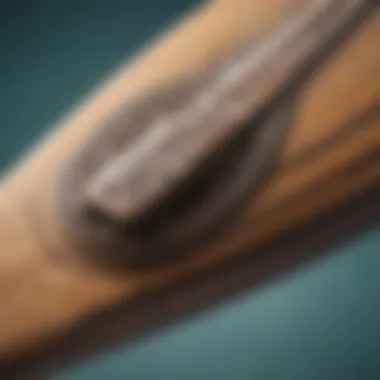
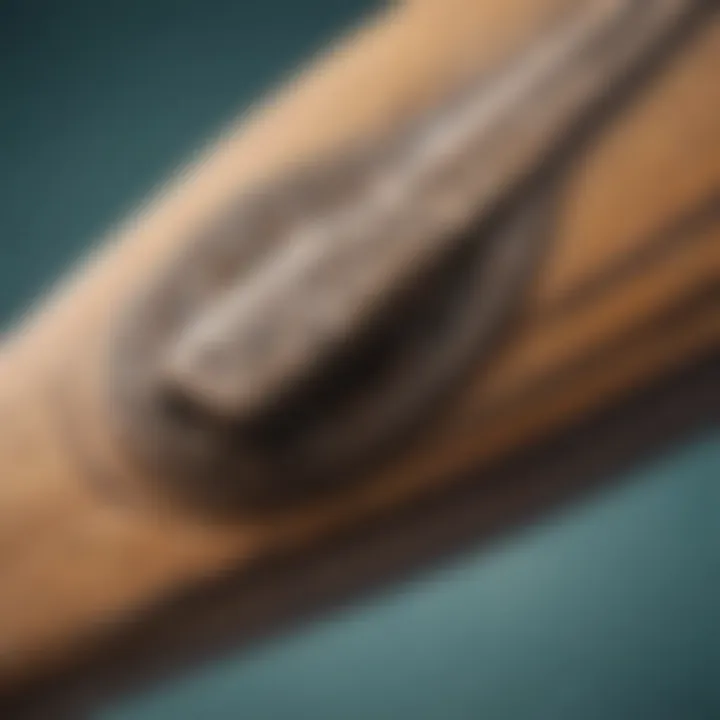
Intro
Kiteboarding is a thrilling sport that marries the power of wind with the excitement of surfing. As with any adventure sport, having the right gear can significantly enhance both enjoyment and performance. One of the often-overlooked pieces of equipment in kiteboarding is the handle. While they may seem minor, kiteboard handles play a pivotal role in how a rider interacts with the kite, controls the board, and ultimately, experiences the water.
In this article, we will navigate through the essential aspects of kiteboard handles, from their design and materials to the different types available in the market. We'll also discuss the connection between handle choice and rider experience. Furthermore, to keep your handles in top shape, we will offer maintenance tips that extend their lifespan.
Whether you are new to kiteboarding or a seasoned athlete, understanding the nuances of kiteboard handles can elevate your performance and pleasure on the water. So, buckle up as we dive deep into the world of kiteboard handles!
"The right handle can turn a good ride into a great one, affecting not just performance but also safety and comfort."
Techniques and Skills
Fundamental Techniques for Beginners
For those just starting to kiteboard, mastering grain skills is vital. The handle is one of the key components that make up the connection between the kite and the board. When beginners learn how to grip the handle properly, they can control their movements more effectively.
- Proper Grip: A firm yet relaxed grip is essential. Holding the handle too tightly can lead to fatigue, while too loose of a grip can result in a loss of control.
- Body Positioning: Ensure your body is aligned with the kite and board. This position can allow for smoother transitions and better control when making turns.
- Weight Distribution: Learning to shift weight while holding the handle helps maintain balance, which is crucial during jumps or hard turns.
Advanced Skills for Experienced Athletes
When a rider progresses, the handle becomes a tool for dynamic expression on the water. Advanced skills involve not just gripping but employing the handle almost as an extension of the body. Some key techniques include:
- Handle Passes: This skill allows riders to pass the handle from one hand to the other while in mid-air, adding flair and style to tricks.
- Unhooked Riding: Riding without being hooked into the handle provides freedom but requires a strong understanding of weight transfer and balance.
- Board Control: Mastering how to maneuver the board while maintaining grip on the handle during high speeds can make the difference in sharp turns or jumps.
Each transition between beginner and advanced levels often involves a more intimate understanding of how the handle interacts with the rider and the kite itself.
Gear Reviews and Recommendations
When selecting a handle, the variety can be bewildering. Here are some recommended products for different skill levels:
- Beginner Handles: Look for models designed to be forgiving, with padded grips and wider sizes like the North Kiteboarding Freestyle Handle.
- Intermediate Handles: A good fit might be the Cabrinha Pro Handle, known for its balance of grip and comfort.
- Advanced Handles: Seasoned riders often prefer the Liquid Force Handle, which boasts customizability and durability for trick-heavy sessions.
Essential Safety Measures in Watersports
Safety should always be at the forefront of any kiteboarding experience. Using a proper kiteboard handle can significantly contribute to safe riding. Key safety measures include:
- Wearing a Life Jacket: Always wear a buoyancy aid that does not obstruct handle use.
- Understanding Wind Conditions: Make sure you’re aware of the wind patterns and their effect on your grip and riding.
- Practice with a Partner: Always have someone nearby who understands the risks and can assist you if needed.
In summary, kiteboarding handles may appear to be just one small element in the vast array of gear; however, their importance cannot be overstated. As water sports enthusiasts, investing time in understanding and choosing the right handle can elevate your entire riding experience.
Prelims to Kiteboard Handles
Kiteboarding is not just about the thrill of riding the waves; it also revolves around the essential equipment that enhances performance, comfort, and safety. One such vital component is the kiteboard handle. In this section, we'll explore what kiteboard handles are, their role in the sport, and why they deserve our attention.
What is a Kiteboard Handle?
A kiteboard handle is essentially a device used to grip and control the kite while riding. It serves as the connection between the rider and the kite, allowing for precise movements and adjustments on the water. The handle can be made up of various materials, shapes, and sizes, depending on its intended purpose.
You might come across different styles of handles, such as basic grips, multifunctional systems, or specialized designs tailored to unique riding styles. Regardless of the type, their primary function remains the same: to provide a secure means for the rider to hold onto while performing maneuvers.
Importance of the Handle in Kiteboarding
The significance of a kiteboard handle can’t be overstated. Without it, controlling the kite becomes a copious challenge. Here’s why the handle is so pivotal:
- Control: A well-designed handle allows for better handling, providing the leverage needed for sharp turns or jumps.
- Comfort: The grip design directly affects a rider's experience. A comfortable handle means less fatigue and more time spent enjoying the ride.
- Safety: During the kiteboarding adventure, the handle plays a critical role in maintaining safety. If the rider loses grip, a secure handle can help prevent falls and collisions.
"The handle is a lifeline in the frantic dance between rider and wind; lose it, and you might as well be trying to steer a ship without a rudder."
Understanding the ins and outs of kiteboard handles helps riders make informed choices about their equipment. Knowing what to look for in terms of design, materials, and fit can significantly influence performance and enjoyment on the water. In the following sections, we will dissect the various types of handles available, delve into material considerations, and consider how to select the right handle for your individual style.
Types of Kiteboard Handles
Understanding the various types of kiteboard handles is crucial for any kiteboarding enthusiast. The handle you choose can significantly affect your riding experience, control, and even your overall performance on the water. Each type of handle is designed with specific purposes and functionalities in mind, aiming to meet the diverse preferences and riding styles of kiteboarders. Whether you’re just starting out or have been a kiteboarding aficionado for years, knowing the differences among handle types will guide you to make an informed choice that suits your kiteboarding journey.

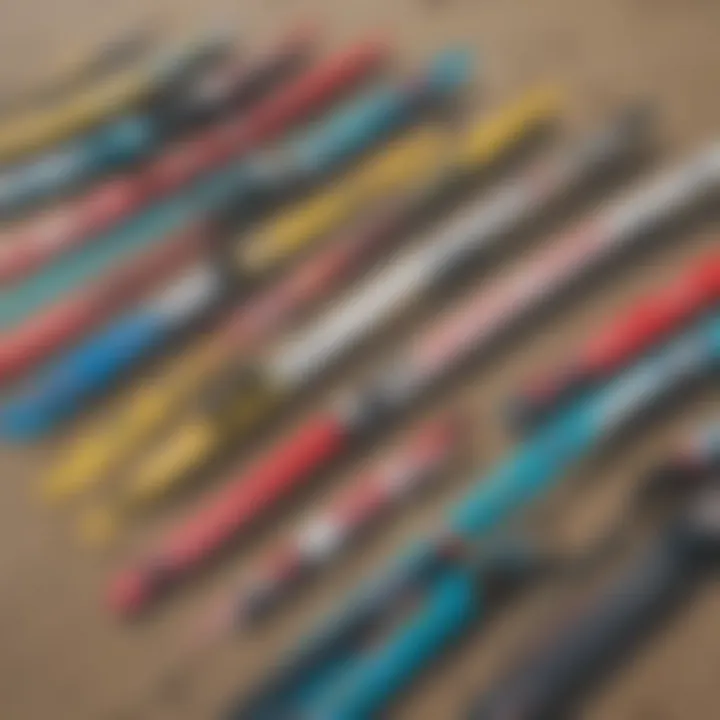
Basic Handles
Basic handles are the most straightforward type available. They are often favored by newcomers to the sport due to their simplicity and ease of use. Typically made of durable plastic or lightweight aluminum, basic handles serve their primary function well: offering a firm grip while you’re out on the water. They usually come without any additional bells and whistles, making them a practical choice for those who prioritize functionality over features.
An added benefit of basic handles is their affordability. For riders who are learning the ropes, it's less of a financial commitment to invest in these types of handles. Furthermore, they tend to be quite lightweight, which helps with maneuverability. This is especially important when you’re still grasping the intricacies of kite control.
Multi-Function Handles
Now, moving on to multi-function handles, these are a notch above their basic counterparts in terms of design and utility. Catering to more advanced riders, these handles often incorporate various features that can enhance your riding experience. One common characteristic of multi-function handles is the inclusion of attachments for accessories, such as straps or safety lines.
With a multi-function handle, you might find it easy to switch between different riding styles along with a broader range of tricks. This versatility can be advantageous, especially for kiteboarders looking to experiment with their maneuvers. However, keep in mind that their added complexity might require some adjustment compared to simpler handles.
Specialized Handles
Lastly, we have specialized handles, designed for specific conditions and riding styles. These are generally favored by seasoned riders who wish to push the envelope of their skills and performance. For example, you will encounter handles made specifically for freestyle kiteboarding, which often are wider to allow for better grip during spins and flips.
An example of this type of handle would be one that has extra padding to reduce impact during landings. Another specialized option can be a handle that includes features to help with unhooked maneuvers. While more expensive, these handles are engineered to provide a significant edge for intermediate and expert riders.
In summary, the types of kiteboard handles range from basic to multi-function and specialized designs, each having its pros and cons. The right handle can greatly affect comfort, safety, and overall performance. As you consider which handle to choose, think about your skills, style, and the specific demands of your kiteboarding adventures.
Material Considerations
When it comes to kiteboard handles, the material they are made from creates a whole lot more than just durability. It's one of those key factors that influences how the handle feels during rides and can significantly impact performance. Each material adds its own flavor to the overall experience, as well as its own set of pros and cons, making the choice rather important for any kiteboarding enthusiast.
Aluminum Handles
Aluminum handles have become quite popular in the kiteboarding community, and for good reason. They are lightweight yet exceptionally strong – a combination that often seems hard to find in the world of outdoor gear. The most notable feature is their sturdiness; they withstand the harshness of ocean conditions without bending or warping.
However, one must also consider that aluminum can get cold on chilly days, which may not be the most pleasant feel during a ride. Additionally, the metal can corrode if not properly maintained, especially when exposed to saltwater regularly. Keeping these handles clean can extend their lifespan, so it’s worth the effort. For riders who value a strong grip and reliable performance, aluminum handles are tough to beat.
Plastic Handles
Plastic handles represent the budget-friendly choice, making them an attractive option for many beginner kiteboarders or those who do not kiteboard often. They’re typically lighter than aluminum and can absorb shock well, which provides a forgiving grip during rough rides. Plastic handles come in numerous styles and colorways, allowing for personalization – an appealing aspect for many riders.
However, beware: plastic handles are susceptible to wear and tear, particularly with constant exposure to UV rays and salty water. They can become brittle over time, leading to breakage. In terms of performance, they may not offer the same level of control and rigidity as the metallic counterparts. While they can deliver a decent experience, serious riders might find themselves looking for an upgrade as their skills improve.
Composite Materials
Composite materials offer a bridge between plastic and aluminum, combining elements of both to create handles that tick several boxes on the wish list for kiteboarders. These materials often blend fiberglass or carbon fiber, delivering a lightweight yet tough product that doesn’t compromise on performance. The notable advantage is they resist the ravages of time better than their plastic counterparts while weighing less than aluminum.
To really hammer down the benefits:
- Durability: Composite handles generally stand the test of time more than plastics.
- Performance: They provide excellent feedback without being too stiff, an ideal middle ground.
- Versatile Design: While they often come in sleek designs, they also allow manufacturers greater flexibility in creating optimized shapes that enhance grip.
One potential downside is the cost. Composite handles usually come at a premium price point, which can be discouraging for those on a budget. However, serious riders often view it as an investment in better performance.
"The handle’s material can make or break your kiteboarding experience, so choose wisely."
In summary, understanding the material considerations of kiteboard handles can lead to more informed decisions. Each option—aluminum, plastic, and composite—offers different benefits and drawbacks. Choosing the right one hinges on your riding style, budget, and what you truly value in your kiteboarding experience. It's essential to weigh these factors carefully before making a purchase.
Design Aspects
Understanding the design of kiteboard handles plays a pivotal role in grasping their significance in kiteboarding. The right handle can significantly improve performance, comfort, and overall enjoyment on the water. An effective handle is designed not just for functionality, but also with an eye for rider experience. It becomes crucial to examine the elements that contribute to its effectiveness, especially grip design, weight distribution, and aesthetic features.
Grip Design and Comfort
Grip design is arguably one of the most vital aspects of kiteboard handles. Comfort in grip can make or break a ride; it's where the rider connects with the board and the kite. A handle with an ergonomic design allows better control during maneuvers and reduces the likelihood of fatigue over extended periods.
Materials play a significant role here. Many handles utilize materials like EVA foam, which provides excellent cushioning against vibrations and slips. An ideal grip should also have a sufficient texture to prevent the hands from slipping, yet should not cause excessive chafing.
In addition, the shape of the grip can influence how a rider positions their hands. Here are a few key considerations:
- Shape: Curved or contoured grips tend to align better with the rider's natural hand position.
- Size: Handles often cater to a range of hand sizes, ensuring a comfortable fit for most riders.
- Padding: Extra padding can enhance comfort, but too much may hinder sensitivity and response.
"A grip that feels right gives the rider confidence. Confidence translates to performance."
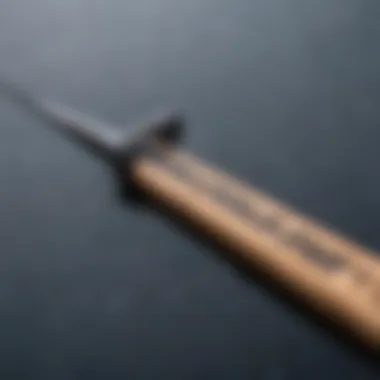
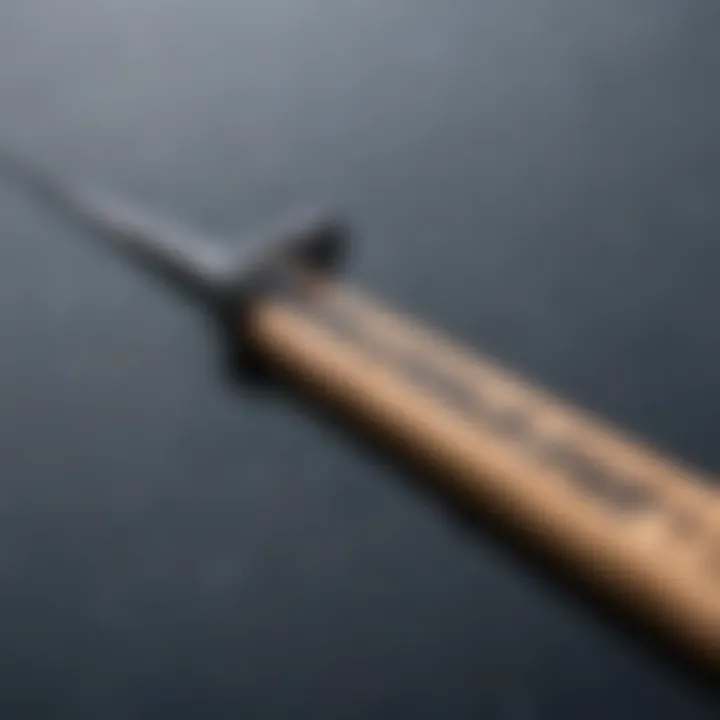
Weight Distribution
Weight distribution is another critical design factor of kiteboard handles. It affects how the rider manages the board and executes dynamic movements. An optimally balanced handle allows for efficient weight transfer, which is vital for high-performance tricks and smooth landings. If a handle feels cumbersome or unbalanced, it can lead to miscalculations during jumps or turns, greatly impacting a rider’s performance.
To achieve an ideal weight distribution, many designers use methods such as:
- Material Selection: Using lightweight materials, for example, can enhance the balance without sacrificing strength.
- Handle Shape: A well-shaped handle distributes weight evenly.
- Connection Points with Lines: The positioning of connection points can significantly affect how weight is felt during use.
Riders often notice that a properly balanced handle helps in maintaining stability, especially during challenging maneuvers.
Aesthetic Features
While performance is paramount, the aesthetic design of kiteboard handles shouldn't be overlooked. A visually appealing handle can enhance a rider's connection to their gear. Aesthetics can range from color choices to unique designs that reflect a rider’s personal style.
Features that contribute to the aesthetic appeal and can attract riders include:
- Color Options: Bright or custom colors can make a handle stand out on the water.
- Graphic Designs: Some brands offer grips with prints or logos that appeal to specific rider communities.
- Finishing Touches: Elements like satin finishes or matte textures can enhance both grip and visual appeal.
It's also worth mentioning that a well-designed handle can function as a part of a kiteboarder's identity, aligning with their overall kiteboarding kit.
Performance Factors
In kiteboarding, the performance of your gear often hinges on seemingly small factors, one of which is the kiteboard handle. While it might not be the star of the show like your kite or board, the handle plays a crucial role in how you interact with the wind and water. It’s one of those elements that can make all the difference between a smooth ride or an unwelcome tumble.
A handle that feels right in your hands can dramatically improve your control, giving you a better feel for the movements you need to execute. When you're soaring through the air or tearing across the water, you might not think about it in that moment, but the handle is central to your experience. It’s the link between you and your kite, translating the shifts in your body into steering and maneuvering. And let's be honest, nobody enjoys that jarring moment when a handle slips or feels misaligned, it's just not good for anyone's rhythm.
How Handle Affects Control
The connection you have with your handle can significantly influence your handling control. Think of it like driving a car; if your steering wheel is too loose or too tight, everything feels off. Similarly, the grip, texture, and design of a kiteboard handle can directly impact the precision and response during your ride. A well-designed handle often features ergonomic grips that enhance your ability to manipulate the kite with finesse.
For instance, if the grip isn't quite right and feels slippery when wet, your response time can be compromised during a critical moment. Riders often report better performance with handles that have a textured surface for improved grip. It makes a world of difference when you’re trying to execute that perfect transition or dodge an unexpected wave.
Additionally, consider the size and shape of the handle. A handle that’s too bulky might hinder your maneuverability, while a smaller one may not provide enough control. Finding a balance that fits your personal preference is essential.
Influence on Tricks and Maneuvers
For those who thrive on the thrill of tricks and aerial maneuvers, the handle becomes even more significant. A handle's design can augment your ability to launch yourself into the air or dive seamlessly back into the water. Techniques such as kite loops or board-offs hugely depend on the way you grip the handle and how effectively you can shift your weight.
In this context, the handle acts as an extension of your body. It is essential to consider how the handle may facilitate or hinder specific tricks. For example, many riders prefer grab handles for tricks like board grabs or rotations. The positioning of the handle can also help control the stability and orientation of the kite as you perform your moves.
"Using the right handle allows for not just stunts, but also helps in recovering from flaws in execution, adding extra safety to your performance."
Over time, you may notice that experimentation with different handles can create subtle shifts in performance. It's about finding what resonates with your style and what complements your skills. It’s advisable to try various options in diverse conditions before making a final choice on a handle. This trial-and-error not only helps build intuition but also connects you deeper with your equipment.
Your handle choice influences each jump, turn, and sail, painting your kiteboarding story. Understanding these performance factors will help you appreciate not just your gear but also the exhilarating sport itself.
Selecting the Right Handle
Choosing the right kiteboard handle is akin to picking the right pair of shoes for a long trek; it can make or break your experience. Handles aren’t just simple grips; they are a vital connection between the rider and the kiteboarding action that unfolds. The right handle enhances control, ensures safety, and contributes towards overall riding comfort. When considering the myriad of options available, it’s crucial for riders to weigh their personal preferences against the specific demands of their kiteboarding style.
Assessing Personal Riding Style
Every kiteboarder has a unique approach, and understanding one’s riding style is fundamental to selecting a fitting handle. Whether you’re a seasoned pro or a novice just entering the fray, it’s important to take the time to appreciate how each handle will adapt to your technique.
- Freestyle Riders: If you’re one who loves performing aerial tricks, a smaller, lighter handle might be preferable. These allow for better maneuverability and precision while you are airborne.
- Wave Riders: Those riding in waves may benefit from a more substantial handle that promotes better grip during tumultuous conditions.
- Cruisers: For casual riders who like to glide along the water’s surface, a comfortable, ergonomic handle might be the best fit. This type generally reduces hand fatigue, allowing longer sessions.
During practice, riders often discover they gravitate toward specific grips or sizes that offer enhanced fun and confidence, so paying attention to what feels right is essential.
Matching Handle to Kiteboard Type
Not all kiteboards are created equal, and the type of kiteboard you’re using will also influence the choice of handle. Different boards have distinct characteristics and catering to them can improve experience and efficiency.
- Twin-Tip Boards: These popular boards usually come with standard handles which provide stability. Look for a versatile handle that fits comfortably into your hands during jumping and landings.
- Directional Boards: If your ride features a more specific design, like a directional board for wave riding, you may want a handle that allows for quick adjustments, be it during a gust or a turn.
- Hybrid Boards: Riders opting for hybrid boards need a flexible handle that complements various riding styles. It’s ideal to select one that offers both performance for tricks and stability for cruising.


Ultimately, understanding the synergy between the kiteboard type and handle will not only boost performance but also enhance enjoyment out on the water. In sum, deliberate consideration and hands-on experimentation with different handles can lead to a more satisfying kiteboarding experience.
Maintenance and Care
Taking care of your kiteboard handle is just as critical as picking the right one. Handles, though sturdy, are often exposed to saltwater, sand, and heavy use. If you want your handle to serve you well for years to come, a little maintenance can go a long way. It’s about prolonging the life of this essential piece of equipment and ensuring that it performs at its best each outing.
Cleaning Tips
Keeping your kiteboard handle clean is crucial for its longevity and performance. After every session, it’s a good idea to wash off any saltwater or sand that might have clung to it. Here are some practical steps:
- Rinse with fresh water: Simply storing or leaving a handle coated in saltwater can potentially degrade materials over time. Rinsing it allows the contaminants to wash away.
- Use a soft cloth: A non-abrasive cloth prevents scratching while gently eliminating stuck-on dirt.
- Check for detritus: Sometimes, sand or debris can get lodged in small crevices. A quick inspection can save you a headache later.
- Avoid harsh chemicals: Always best to steer clear of strong cleaners that might damage the handle materials.
A clean handle not only looks better but ensures a steady grip when you’re out on the water. The advantages of proper cleaning are two-fold: enhanced performance and increased safety while kiteboarding.
Storage Best Practices
How you store your kiteboard handle can also dictate its lifespan. Following these storage tips helps to keep your equipment in prime condition:
- Store in a dry place: Moisture can lead to rusting on metal components, or degradation of plastic handles. Keeping them dry ensures they stay in good shape.
- Avoid extreme temperatures: Kites and their parts should never be left in a hot car or exposed to freezing conditions. These temperature extremes can warp materials.
- Use protective bags: Many kits come with a travel bag for safekeeping. If you’ve got one, use it to protect from dust and impacts.
- Inspect handles before storage: Look for any signs of wear or damage that may have crept up during usage. If you spot an issue, consider replacing the handle before the next use.
With careful attention to cleaning and proper storage, kiteboard handles can last significantly longer, offereing you quality performance every time you hit the waves.
Safety Factors
When engaging in kiteboarding, prioritizing safety is not just an option; it's a necessity. The kiteboard handle, often overlooked, plays a significant role in ensuring a safe experience on the water. Understanding how to inspect and use your handle properly can be the difference between a thrilling ride and an unwelcome accident.
Inspecting Handles for Damage
A crucial aspect of your safety routine involves inspecting your kiteboard handle for any signs of damage. Regular inspections go beyond just a quick glance. Here are some key points to consider:
- Visual Check: Look out for cracks, frays, or any other signs of wear. Much like checking your tires before a long drive, this shouldn't be skipped.
- Flexibility Test: Gently flex the handle. If it feels too stiff or shows changes in its usual flexibility, that may mean it’s on its last legs.
- Attachment Points: Ensure that the handle's attachment points are secure. If these areas seem loose, it's best to take immediate action.
- Inspection Frequency: Make inspections a part of your routine — ideally before every session. Just like a chef wouldn’t start cooking with dull knives, you shouldn’t hit the water with a questionable handle.
Taking the time to inspect your gear can save you from critical mishaps; after all, an ounce of prevention is worth a pound of cure.
Proper Usage Techniques
Using your kiteboard handle correctly is equally essential for maintaining safety on the water. Here are some ideas to keep in mind:
- Grip Technique: Ensure you're holding the handle with a relaxed grip. Tension might lead to unintended jerks, which can throw off your balance.
- Body Positioning: Keep your body aligned with the handle. Twisting or turning too much while holding on can invite trouble — think of it like steering a bicycle: if your handlebars are turned too sharply, you’ll find yourself tipping over.
- Use Two Hands: Whenever possible, use both hands. This not only gives you better control but also ensures that if one hand slips, you won't lose total grip of the handle.
- Stay Alert: Pay attention to the conditions around you. Wind, water currents, or even fellow kiteboarders can impact your ride. Be ready to adjust quickly, just like how a surfer reads waves.
Maintaining a proper hand position and being aware of your surroundings can greatly minimize the risks associated with kiteboarding.
Remember: Safety is not merely about having the right gear but also knowing how to utilize it effectively.
Future Trends in Kiteboard Handles
As the world of kiteboarding continues to evolve, so too do the handles that define rider experience. Understanding the future trends in kiteboard handles is crucial for anyone involved in this sport. A handle is not just a tool; it is the connection between the rider and the kite. Therefore, staying informed on upcoming advancements allows riders to make informed choices that can significantly enhance their performance and safety on the water.
Innovative Materials
In the ever-evolving landscape of kiteboarding, innovative materials have emerged as a game-changing element. Kiteboard handles are transitioning from traditional materials, like aluminum and plastic, to more advanced composites. These new materials offer numerous benefits:
- Strength and Durability: Modern composites provide a balance of strength without considerable weight. Unlike aluminum, which can bend or warp under stress, these materials are designed to maintain their integrity.
- Lightweight Construction: Riders want gear that doesn’t weigh them down. Innovative materials are lighter, making it easier to perform those high-flying tricks without feeling burdened by cumbersome handles.
- Corrosion Resistance: Kiteboarding often involves saltwater exposure. New materials resist corrosion, ensuring the longevity of handles even under harsh conditions.
Adoption of these materials is not only trending but essential for an improved kiteboarding experience. With manufacturers continually searching for lighter yet stronger options, we can expect to see more kiteboard handles in the market that boast these cutting-edge materials.
Advancements in Design Technology
Cutting-edge design technology is are reshaping how handles are made and perceived in kiteboarding. This is not merely a cosmetic shift, but a move toward functionality that enhances performance.
Some critical advancements in design include:
- Ergonomic Shapes: Riders are increasingly sensitive to comfort, especially during longer sessions. Advances in design now allow for handles that conform to the natural contours of the hand, minimizing fatigue and enhancing grip.
- Adjustable Features: The emergence of customizable features is making waves. Some handles now allow users to adjust the distance from the body or alter the grip orientation, which caters to individual preferences.
- Integrated Technology: Innovations are even incorporating tech directly into handles. This could mean built-in sensors that measure performance metrics, allowing riders to gauge their progress and refine their skills in real time.
Through these advancements, the way riders interact with their kiteboards is becoming increasingly intuitive and responsive, pushing the sport to new heights.
"The only constant in kiteboarding is change, and being at the forefront equates to improved performance and enjoyment."
In summary, as kiteboard handles evolve, understanding these future trends becomes pivotal for any serious water sports enthusiast. The shift towards innovative materials and smarter design approaches is not just a minor detail—it's a beacon guiding the future of kiteboarding performance.















